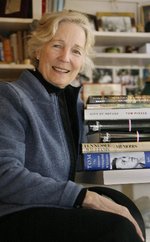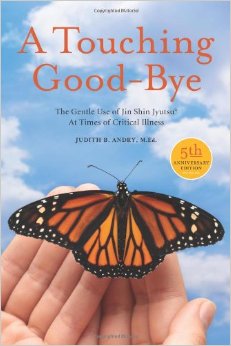Today SevenPonds speaks with Judy Andry. Judy Andry has been studying Jin Shin Jyutsu since 1984. She was one of the first three members of the Jin Shin Jyutsu Advisory Council in 1998 and she has a small private counseling practice in New Orleans. She is the author of the book A Touching Goodbye: The Gentle Use of Jin Shin Jyutsu At Times of Critical Illness and Death, which focuses on the impact that Jin Shin Jyutsu can have on those who are nearing the end of life.

Credit: Kathy Anderson
Kimberly: When your clients don’t get better, does Jin Shin Jyutsu still have a positive impact on their lives?
Judy: It is so good and calming that it does help people, especially those on chemotherapy, with relaxing and sleeping better. When people who aren’t aware of what to do go to someone who is sick, they will often touch their arms or rub up and down, and this is actually very painful for someone who is on chemotherapy. Jin Shin Jyutsu is not that at all. Jin Shin Jyutsu is just touch and often times it is holding specific places, like the fingers or the toes and being calm. You can literally feel the person relaxing. Their breathing gets better; they calm down and the fear goes away.
Kimberly: What was your experience like in bringing Jin Shin Jyutsu to New Orleans?
Judy: It took me forever to figure out a way to explain it. Nobody I knew had any inkling of anything like this. I had a few friends who were just great, who would say, “Don’t tell me, just do it to me,” so I would do it to them and they would love it. I would often tell people, “don’t ask about it, just let me do it to you and you’ll know,” which is true. With my husband, I would start giving some verbal answer, and he would look at me and say “You’ve got to figure out a way to tell this better,” so he started researching Eastern medicines and came up with a book list on this. Any time I had a thinker on the Jin Shin Jyutsu table, I’d give them the book list. Nobody I know has ever read any of the books, but they felt totally confident about the book list in the hands.
Kimberly: Among your clients, have you worked with children as well?

Credit: Wikipedia
Judy: I’ve worked with a few children. My friend, who went out with me for my first time, she was called by a lady who asked if we could work with her child. This lady brought over her child and my friend started working on him. She worked on this child for about two months and after about two months they were there one day and the child started making sounds. Then my friend and the mother looked at each other and one of them said, “I think he is laughing!” The child was never able to do anything well like walking, but after the Jin Shin Jyutsu, he was able to walk and do something well and participate in activities at special schools.
Kimberly: How can Jin Shin Jyutsu help people accept death?
Judy: I was helping one woman in a hospital who had called me to practice Jin Shin Jyutsu on her. So I went to her and I sat there on the right side of the bed. I had my left hand holding the palm of her hand and I would hold each of her fingers for five minutes or so. After about a minute, the woman looked at me and said “there is more to this than what you are doing, isn’t there?” because the swelling was finally releasing from her body. After a while, she asked me politely not to come back, because if the hospital saw that she was getting better, they wouldn’t let her go home. So I left and a couple days later she died there in the hospital.
The woman looked at me and said “there is more to this than what you are doing, isn’t there?”
Jin Shin Jyutsu is a wonderful way to teach people to be around those who are dying. When someone is dying there is often a lot of rushing around as people talk to them and pat them and Jin Shin Jyutsu brings such calmness and peace to the scene. You are not trying to cure them. You are just being present.
Kimberly: Thank you for your time Judy!
Judy: Thank you!
Related SevenPonds Articles:
- What is Jin Shin Jyutsu? An Interview with Judy Andry: Part One
- What is integrative massage therapy? An interview with Christine Brusati
- How Can Art Therapy Benefit Someone Dealing with Loss and Grief? An Interview with Melissa J. Hedlund

 What is Jin Shin Jyutsu? An Interview with Judy Andry: Part Two
What is Jin Shin Jyutsu? An Interview with Judy Andry: Part Two


 Our Annual Seven Holiday Gifts for Someone Who Is Grieving, 2024 Edition
Our Annual Seven Holiday Gifts for Someone Who Is Grieving, 2024 Edition
 “Making Mobiles” by Karolina Merska
“Making Mobiles” by Karolina Merska
 “Hands Up to the Sky” by Michael Franti & Spearhead
“Hands Up to the Sky” by Michael Franti & Spearhead














